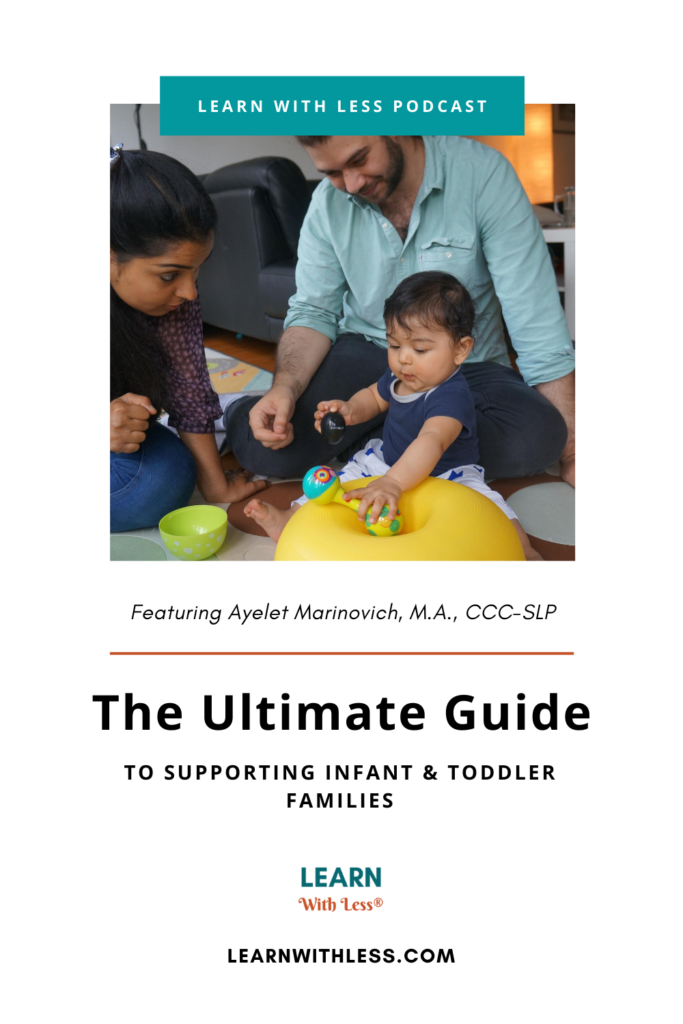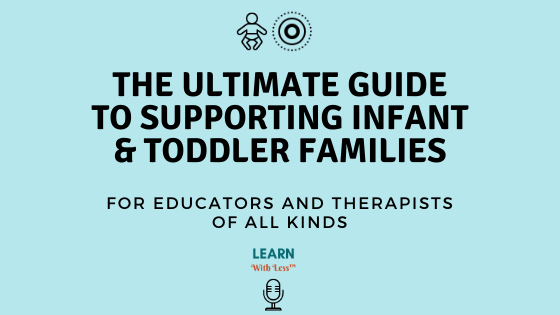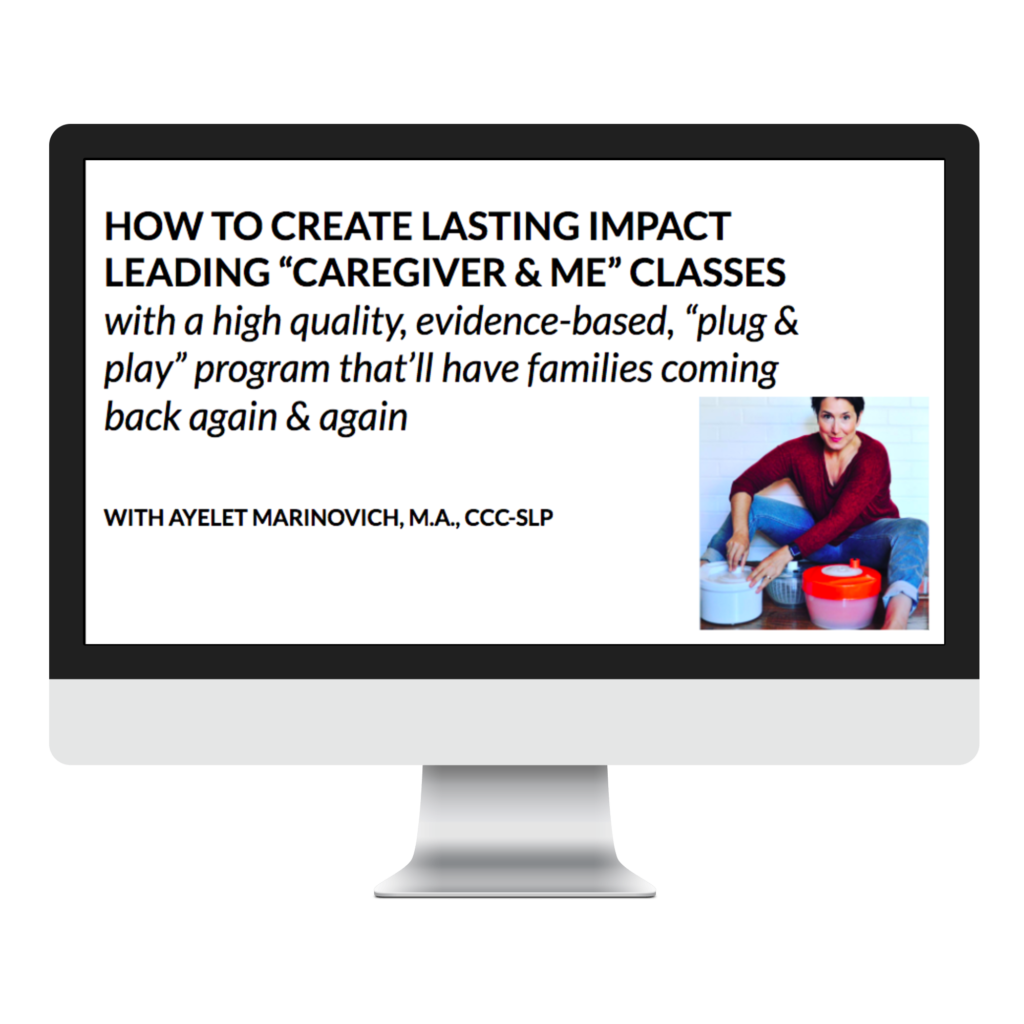Families already have all the “right” tools to support their babies: they just need to know how to use them.

In today’s episode, I’m going to be sharing with you the ultimate guide to supporting infant and toddler families through parent education. Because here’s the thing: The single most important thing your families need to realize about supporting their young child’s development is that they already have all the “right” tools to support their babies: they just need to know how to use them.
All around the world, educators and therapists working with families with infants and toddlers are moving to a “routines-based intervention” approach.
Essentially what that means is that the research is finally catching up with what professionals in early childhood education have known for a long time: tiny humans must be supported by responsive caregivers, and do this best in their natural environment.
In the first few years of life, children learn through a process of observation (observing others), imitation (starting to imitate others) and interaction (interacting with objects in the environment and with other people in the environment).
And everyday routines are those common threads that help children make sense of the world, and help them learn about basic concepts, about vocabulary for things around them, about how their bodies move and how the world feels, and about how to engage socially with others.
So when parents and caregivers can learn to maximize the everyday routines and everyday objects that they’re often already participating in and using, they can unlock their potential and boost development… and this, in turn, gives them the peace of mind they crave: it empowers them to do the big job of parenting tiny humans. They get to combat the overwhelm of early parenthood.
Parenting is that great equalizer, and no matter where your families come from, what language(s) they speak, what socio-economic bracket under which they fall, or whether a child is developing along a typical progression or whether she falls outside the norm, there’s one single thing we all need to realize:
When you can help families learn to recognize the tools they already have to boost their young child’s development, you’re able to help them maximize the time they have with their babies, you help them feel empowered to “get it right,” and you’re able to help them unlock the power of everyday routines (diaper) and everyday objects (paper roll) to figure out how to support their tiny human and boost all areas of development.
Play, Talk, Sing, Move
So what are the kinds of things we as educators and therapists can do to support young children and their families? What are the things we can show parents and caregivers that can help them infuse every single interaction with more connection, more opportunities for interaction, more vocabulary, more modeling?
I see these as play, talk, sing, and move. I refer to these as the 4-pillars of Learn With Less®. I come back to these in each one of my therapeutic sessions as a pediatric speech-language pathologist, in everything I model and discuss with client families, and in all my parent education work with Learn With Less®.
Now, the ultimate goal both with direct therapy and with any kind of parent education or enrichment class, is to build family capacity, competence, and confidence.
THEREFORE, this means that your job as a parent educator or a therapist of any kind is to help parents and caregivers believe they can make a difference with their child… and you can do that using very simple strategies and very simple materials!
As a pediatric speech-language pathologist, parent educator, and imperfect mother of two young children, I see so often that parents and caregivers often get caught up with the idea of finding the “best route” to follow, and then, instead of thinking things through or thinking about why they believe something is the best or why a certain material holds specific developmental value, they become a “blind follower” to the tool they’re using or philosophy they’re following.
Your job as a parent educator or therapist, in many ways, is to help them think for themselves. It’s to show them that the materials you’re using don’t matter. Because – they ARE going to get fixated on the materials! I kid you not, I’ve literally had a mom say out loud without even thinking about it as her baby was reaching and grasping for an empty toilet paper roll, “We’re going to have to go and get one of these!” We had a good laugh about that when she realized what she had just said. But we are conditioned to want to go out and get the best for our babies! And because the baby industry is so strong, we believe we have to go out and buy things to support development.
So it’s not about the materials. It’s what you infuse the experience with that matters.
In the Learn With Less® curriculum, I encourage families to use four basic pillars to connect with their little ones. These are the pillars of play, talk, sing, and move, and these pillars allow us to connect as a group, and allow me to facilitate and model to other caregivers. Today, I’m going to break those down for you.
As a facilitator of caregiver/baby groups, a parent educator, or a therapist of any kind, these four pillars will help you provide families with the foundation for learning and connection, and will help you break down early development so parents and caregivers can think about supporting their infants and toddlers through simple, manageable steps. Pointing out these pillars allows you as an educator to set a warm and friendly tone with both caregiver and child, and allows you to use the languages of play, talk, sing, and move to connect, facilitate, and model to other caregivers.
So what are the kinds of things we can do to support young children? That can infuse every single interaction with more connection, more opportunities for interaction, more vocabulary, more modeling? What does that mean for our little ones?
First, we want to define PLAY with attention to the following principles:
Open-ended play – meaning, we want to encourage caregivers to engage in exploration of the environment and of everyday objects, and being playful can simply mean
Exploring, experimenting, and offering varied environments and varied objects
Most importantly: we want to help adults see that being playful is a different way to look at what we, as we grown ups, come to define as play: many adults come into the idea of “playing with their child” as following a set of rules of a game, like, we hit the ball, we run, we score! Or, as a procedural exercise: we open the book, we read the page, we turn the page, repeat!
So, encouraging caregivers to “play” with NO specific end goal in mind can really require them to reframe their entire thinking!
Now, of course, in a therapeutic context, you are going to want to weave whatever skill you’re working on into the play! SO whether it’s turn-taking, eye gaze, joint attention, imitation, gesture use, first words, or building on existing verbal language…
We want to create an environment where the caregiver is encouraged to be flexible and accepting of what is happening, what might happen next, and what their child is doing
And finally, within that play, we want to ensure safety with a variety of materials.
Next, we want to define this second pillar, TALK, with attention to the following principles:
We want to help caregivers recognize that just by having discussions with their (potentially pre-verbal!) baby or toddler, just by making observations alongside their child, they are creating a language-rich environment.
We want to encourage them to engage in the gold standard of early learning: repetition with variation, which we’ll talk more about in a few minutes. So helping them see the value in all those everyday experiences like the diaper change and the sitting down to a meal or the bath or the waking up or going to bed routine… all those are opportunities for repetition… and tiny variations they can make, with a change of pace, with a change in attention, with the addition of a choice-making opportunity, with a little song, and so on… that is the way to go!
We also want to help them remember that the drill and kill kind of “what’s this, what’s this, what’s this” labelling that many parents get stuck in (because they want their child to show them how much they know!) is just one of maaaaaaany reasons we communicate – labeling is just one way we can talk about things, but so is asking questions, so is making requests, so is greeting, and so many other parts of joint attentional acts and socially interactive acts, and behavioral regulation acts…
And we want them to recognize that we ALL communicate using a variety of means and modes – not just with words, but all those precursors to language, and all those additional ways like eye gaze, and facial expression, and gestures, and moving closer to an object…
We want to help them recognize that modeling our own curiosity, talking about our own feelings, imitating their vocalizations and verbalizations and movements… are all supporting various areas of communication…
And finally, we want them to realize that they are the primary language models. They are the ones modeling what they want their child to then imitate. So not only do we want to help them model a wonderful variation of vocabulary, and the formation of sentences, etc., but we also want them to model positive behavior, positive communication styles, and we want them to talk to their children and around their children in the ways we want them to eventually do the same to us.
And now we come to SING, the one people often have the most trouble gathering resources and just doing.
But we want to give families the chance to realize that this pillar of “sing” doesn’t necessarily mean singing everyday and in every way with their child. There are soooo many ways to be musical with young children.
But because music is so powerful, I really encourage you to give them ways to just feel at ease trying things out (by modeling your imperfection, as well!), and using music to add a silly element to a simple routine like the diaper change – “stiiiiiiiinky diaper, it’s tiiiiiime for a new one!” or “is there a poopoo in there, is there a poopoo in there? Was it only air or is there poopoo in there?”
We want to help them see that simply by adding “you pooped, you pooped, you really really pooped” is adding joy into a routine!
And just by using a melody or a change in pace or rhythm, we can distract a child or engage a child… using musicality!
We also want to encourage them to remember that rhythms ARE everywhere – that nearly everything can become a percussive instrument (and their child playing with a bowl and wooden spoon IS a musical experience!)
… because they can make music with what they already have. They might have a few lovely instruments, a wooden drum, a few maracas… but they might also have a poster tube full of dried beans or an upside down laundry basket. And you’re here to show them how to make use of those!
Finally, we want to define this last pillar, MOVE, with attention to the following principles:
Movement. IS. Life. Their child learns about… everything… by learning how his body moves, where it is in space, by solving the problem of how to balance and lift and figuring out elements of force, of gravity, and of becoming the scientists that they are… through movement.
So, we want them to remember that even with a tiny baby or a child with motor challenges, they can consider various movement planes – whether it’s during tummy time or a dance party or a lullaby, whether it’s to stimulate or regulate.
And exploration, which is learning, cannot be contained. So we might have some movement in and out of the location where the session started. We might be sitting up or laying on the floor. We might be mouthing something or exploring how one surface is different from the next.
The Way Forward
Now, I want to finish by, again, reminding you that the way forward in early intervention, in routines-based intervention, or in any family enrichment workshop or class… is not about you getting to show off all your cute therapy toys, or getting to use your laminator.
For EVERY single material you use (if you bring it into the home, if you provide materials within a group, or if you use what’s already there), try to think of the most basic version.
In our use of everyday items, we are educating caregivers that they don’t need what you have: they can use what they already have in their own home, regardless of how “much” or how “little” they have!
Your clients are a diverse set of caregivers and children who may or may not be accustomed to playing with a variety of materials. They may have started your session already having spent the morning in a cardboard box or the kitchen cabinets… or the caregiver may be completely opposed to their child using their kitchen as a play space.
And the latter? THAT’S OK! That is their right. So if they’re just not comfortable, find another way, another material, another space.
Remember, we’re building family capacity, family confidence, and family competence.
You’re making attempts at creating an environment for exploration, you’re providing examples for ways they can engage with their own children. You’re giving them ideas about how they might generalize at home or when you’re not there. You’re showing examples – you’re not giving them the “right” way to parent.
Your model and your structure provides them with a new set of eyes, a new way to see what they already have and what they can use and do… should they wish to implement that without you.
They may start to see, over time, that “controlled chaos” is maybe sometimes ok. That mess is not always terrible, or that they can create “mess” in ways that are more comfortable than others.
And they may start to see that the value of those little moments in between… are actually incredibly powerful.
Parents and caregivers often define “learning” and “play” in more adult terms – this is often something that manifests itself in activities like book reading. Clients often express to me that the “problem,” for instance, when they sit down with a book with their young child is that their toddler just wants to “remove all the books out of the book stand” or “just wants to turn the page for no other reason than just to turn the page.”
When I dig a little bit deeper with them about what about this “irks” them, they often explain that they simply want their child to attend to something interesting or special in the book, or they know that book-reading and early literacy is important.
So that means that there are a lot of levels of parent education that we as clinicians have to do about how all young children learn.
So here we are. Families need a guide. They want to know how “best” to help their children. That guide can be you.
Remember where they are. Often overwhelmed, sleep-deprived, anxious, and needing to be reassured they are doing all the things “right.”
They all want to do enough for their children. Every single parent wants this.
The strategies we’ve discussed today focus on empowering the family, creating confidence, helping them feel competent, and and building their own capacity: helping them see what they’re capable of, and giving them the eyes to see the value of what they’re already doing – adding just a few tweaks to their mundane everyday moments.
I believe that a very powerful way to do that is through community based caregiver/baby classes.
And I’d love to share the knowledge that I’ve gained over the last 6 or so years, creating my own curriculum and sharing it with families all over the world, both virtually and in-person. I’d love to share with you our community of facilitators who are also leading classes using the Learn With Less® curriculum with families, diversifying their income streams, and creating social impact on families in their communities.
I invite you to apply now to the Learn With Less® Facilitator Training & Certification Program. When you do, I’ll be reviewing your application. If you’re a good fit, I’ll share with you my private training all about how to create lasting impact on families in your community, using a high quality, evidence-based, “plug & play” program that’ll have families coming back again and again.
In addition, I’ll be gifting you my “caregiver & child classes roadmap,” which will help you discover how to promote parent education about play and development, facilitate opportunities for early parent support, establish yourself as a resource and leader, earn an income, and create a steady stream of clients for your other services. This roadmap will show you the six areas you’ll need to consider so the overwhelm of starting your own thing doesn’t stop you in your tracks before you even begin, and so you don’t have to reinvent the wheel when it comes to leading caregiver/baby classes in your local community.
I can’t wait to hear what you think!


